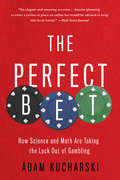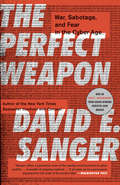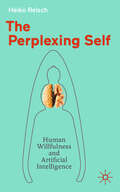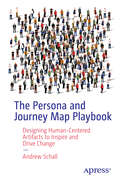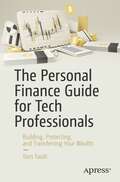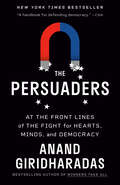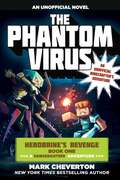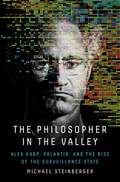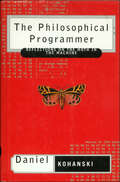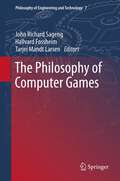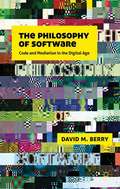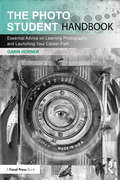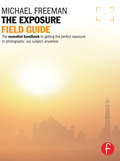- Table View
- List View
The Perfect Bet: How Science and Math Are Taking the Luck Out of Gambling
by Adam KucharskiThere is one thing about gambling that everyone knows: the house always wins. Lotteries are set up to guarantee profits, to the state. A craps game is a sure thing, but only if you own the table. Sometimes, however, everyone is wrong. After all, the reason that casinos ban card counters is that counting cards works. Indeed, for the past 500 years, gamblers-led by mathematicians and scientists-have been trying to figure out how to turn the tables on the house and pull the rug out from under Lady Luck. In The Perfect Bet, mathematician and award-winning writer Adam Kucharski tells the astonishing story of how the experts have done it, revolutionizing mathematics and science in the process. From Galileo to Alan Turing, betting has been scientists' playground for ideas: dice games in sixteenth-century bars gave birth to the theory of probability, and poker to game theory (mathematician John von Neumann wanted to improve his game) and to much of artificial intelligence. Kucharski gives us a collection of rogues, geniuses, and mavericks who are equally at home in a casino in Monte Carlo as investigating how to build an atomic bomb for the Manhattan Project. They include the mathematician who flipped a coin 25,000 times to see if it was fair; the college kids who gamed the Massachusetts lottery to yield millions of dollars in profit; and the horse-betting syndicates of Hong Kong's Happy Valley, who turned a wager on ponies into a multi-billion-dollar industry. With mathematical rigor and narrative flair, Adam Kucharski reveals the tangled history of betting and science. The house can seem unbeatable. In this book, Kucharski shows us just why it isn't. Even better, he shows us how the search for the perfect bet has been crucial for the scientific pursuit of a better world
The Perfect Photo
by Elin Rantakrans Tobias Hagberg"Perfect" is a purely subjective term when it comes to art. A journey toward the perfect photo is a journey without a defined destination. There are photographs that are technically perfect and others that stand out because of their message or composition. Although the perfect photo remains a matter of taste, it is still something every photographer strives for. With this volume, Elin Rantakrans and Tobias Hagberg provide the beginning to intermediate photographer a wide range of practical tips that cover capture, composition, and editing--all with the aim of helping you achieve better photos. Each concept is illustrated with beautiful, inspiring images. Our promise: Use 7 of these 70 tips and you will be a 10% better photographer. Try it!
The Perfect Weapon: War, Sabotage, and Fear in the Cyber Age
by David E. SangerNOW AN HBO® DOCUMENTARY FROM AWARD-WINNING DIRECTOR JOHN MAGGIO • &“An important—and deeply sobering—new book about cyberwarfare&” (Nicholas Kristof, New York Times), now updated with a new chapter.The Perfect Weapon is the startling inside story of how the rise of cyberweapons transformed geopolitics like nothing since the invention of the atomic bomb. Cheap to acquire, easy to deny, and usable for a variety of malicious purposes, cyber is now the weapon of choice for democracies, dictators, and terrorists. Two presidents—Bush and Obama—drew first blood with Operation Olympic Games, which used malicious code to blow up Iran&’s nuclear centrifuges, and yet America proved remarkably unprepared when its own weapons were stolen from its arsenal and, during President Trump&’s first year, turned back on the United States and its allies. And if Obama would begin his presidency by helping to launch the new era of cyberwar, he would end it struggling unsuccessfully to defend the 2016 U.S. election from interference by Russia, with Vladimir Putin drawing on the same playbook he used to destabilize Ukraine. Moving from the White House Situation Room to the dens of Chinese government hackers to the boardrooms of Silicon Valley, New York Times national security correspondent David Sanger reveals a world coming face-to-face with the perils of technological revolution, where everyone is a target.&“Timely and bracing . . . With the deep knowledge and bright clarity that have long characterized his work, Sanger recounts the cunning and dangerous development of cyberspace into the global battlefield of the twenty-first century.&”—Washington Post
The Performative Presidency
by Jason L. MastThe Performative Presidency brings together literatures describing presidential leadership strategies, public understandings of citizenship, and news production and media technologies between the presidencies of Theodore Roosevelt and Bill Clinton, and details how the relations between these spheres have changed over time. Jason L. Mast demonstrates how interactions between leaders, publics, and media are organized in a theatrical way, and argues that mass mediated plot formation and character development play an increasing role in structuring the political arena. He shows politics as a process of ongoing performances staged by motivated political actors, mediated by critics, and interpreted by audiences, in the context of a deeply rooted, widely shared system of collective representations. The interdisciplinary framework of this book brings together a semiotic theory of culture with concepts from the burgeoning field of performance studies.
The Perplexing Self: Human Willfulness and Artificial Intelligence
by Heiko ReischPeople attribute a self to themselves. The sciences struggle to define what it is and how it comes about. However, they are certain that we have it and need it. For researchers, it is scarcely tangible and thus a tricky problem. The development of strong AI will fail because of this; humans remain something else
The Persona and Journey Map Playbook: Designing Human-Centered Artifacts to Inspire and Drive Change
by Andrew SchallMost personas and journey maps crash land shortly after takeoff. This step-by-step playbook provides a revolutionary approach to creating these pivotal artifacts in product design through the concept of altitudes. They will guide you in conceptualizing your users through research techniques that directly inform persona characteristics. Discover how to create personas that are free from irrelevant attributes and learn to develop high-altitude personas with sufficient lift to guide product roadmaps and organizational strategy. You'll also master constructing flight paths for journey maps that capture the user’s journey at the perfect level of detail, uncovering key moments in their experience. Then, as personas and journeys evolve, you will learn to measure the impact of product experience improvements. With this book as your co-pilot, you'll navigate the creation process with the help of templates and real-world examples reflecting the latest methods for personas and journey maps. The Persona and Journey Map Playbook will provide you with the tools and strategies to create impactful personas and journey maps that will drive user-centered design and product success. What You’ll Learn Integrate personas and journey maps into a cohesive user experience strategy. Gain practical details to design for users, avoiding common pitfalls of stereotyped and irrelevant personas. Utilize user research activities and synthesize insights to inform personas and journey maps. Understand the root causes of user experience issues through personas and journey maps to inform product roadmaps, create user requirements, and document future experiences. Who This Book Is For Product leaders, user experience designers, user researchers, or any roles responsible for understanding user needs.
The Personal Branding Playbook: Turn Your Personality Into Your Competitive Advantage
by Amelia SordellTake control of your personal brand and become a person of influence today. Everyone has a personal brand. You have a personal brand with the people you work with, the people you love, the people who serve you your morning coffee and the people who you greet on your morning commute. Every single interaction we have builds a picture of who we are as a person - a personal brand. But what that personal brand looks like depends on whether or not you're willing to take control of your own narrative, or allow other people to write it for you. Written by Amelia Sordell, founder of one of the world's leading personal branding agencies, The Personal Branding Playbook: Turn your personality into your competitive advantage reveals the strategy and tactics Amelia used to build a reach of over 100 million people and a 100% inbound model. This tactical guidebook will first show you how to take control of your personal brand and build an entirely authentic reputation that drive real results. It's strategic take on leveraging your personality to win great clients, attract awesome opportunities and accelerate your personal and professional growth. The Personal Branding Playbook draws on Amelia's real life experience to show how you to: Craft your story. Design your personal brand strategy. Share your story with the world online. Build a community of loyal fans, not followers. Drive inbound leads, opportunities and introductions. Position you as the option, not just an option in your market. Engaging, practical and refreshingly honest, The Personal Branding Playbook: Turn your personality into your competitive advantage is packed with real failures, successes, lessons and strategies from the author, Amelia Sordell's life. This book is the ultimate guide to helping CEOs to freelancers and students leverage their unique personality to gain advantage, and become a person of influence.
The Personal Finance Guide for Tech Professionals: Building, Protecting, and Transferring Your Wealth
by Tom TaulliGain a a basic foundation of essential personal finance issues and strategies, specifically geared towards tech professionals. The book will build on the concepts, such as going from the basics of investments to more advanced topics like alternative investments and tax strategies.In the U.S., about 6 million tech startup employees have stock options. The result is that this can often be the biggest source of wealth, sometimes reaching into the millions. Yet there are many financial and tax complications that have been aggravated with the transition to remote work. This can mean lower returns and missed opportunities, and in some cases, employees may even be subject to actions from the IRS and local tax agencies. The Personal Finance Guide For Tech Professionals is packed with actionable advice and covers the main areas that any tech professional will face.What You'll LearnTrack and analyze investments with fintech appsImprove the results of freelance work, such as with strategies to lower taxesProtect your hard-earned assets with insurance and the establishment of entities like LLCs Who This Book Is ForThe main focus will be on tech employees who get equity compensation. This spans from entry level people to senior executives.
The Persuaders: At the Front Lines of the Fight for Hearts, Minds, and Democracy
by Anand GiridharadasNEW YORK TIMES BESTSELLER • An insider account of activists, politicians, educators, and everyday citizens working to change minds, bridge divisions, and fight for democracy—from disinformation fighters to a leader of Black Lives Matter to Bernie Sanders and Alexandria Ocasio-Cortez and more—by the best-selling author of Winners Take All and award-winning former New York Times columnist&“Anand Giridharadas shows the way we get real progressive change in America—by refusing to write others off, building more welcoming movements, and rededicating ourselves to the work of changing minds.&” —Robert B. Reich, best-selling author of The SystemThe lifeblood of any free society is persuasion: changing other people&’s minds in order to change things. But America is suffering a crisis of faith in persuasion that is putting its democracy and the planet itself at risk. Americans increasingly write one another off instead of seeking to win one another over. Debates are framed in moralistic terms, with enemies battling the righteous. Movements for justice build barriers to entry, instead of on-ramps. Political parties focus on mobilizing the faithful rather than wooing the skeptical. And leaders who seek to forge coalitions are labeled sellouts.In The Persuaders, Anand Giridharadas takes us inside these movements and battles, seeking out the dissenters who continue to champion persuasion in an age of polarization. We meet a leader of Black Lives Matter; a trailblazer in the feminist resistance to Trumpism; white parents at a seminar on raising adopted children of color; Bernie Sanders and Alexandria Ocasio-Cortez; a team of door knockers with an uncanny formula for changing minds on immigration; an ex-cult member turned QAnon deprogrammer; and, hovering menacingly offstage, Russian operatives clandestinely stoking Americans&’ fatalism about one another.As the book&’s subjects grapple with how to call out threats and injustices while calling in those who don&’t agree with them but just might one day, they point a way to healing, and changing, a fracturing country.
The Phantom Virus: Herobrine?s Revenge Book One (A Gameknight999 Adventure): An Unofficial Minecrafter?s Adventure (Gameknight999 Series)
by Mark ChevertonHerobrine has crafted an evil game for Gameknight999 to play.Herobrine, the artificially intelligent virus, was deleted. The computer it resided in was completely destroyed. Without their leader, the few survivors of its evil army were cast away into the shadows. It looked as if there would finally be peace and happiness throughout the servers of Minecraft.But suddenly, and mysteriously, software began misbehaving. Sheep fell from the sky. Snowballs appeared out of nowhere. What seemed at first like harmless glitches quickly became dangerous. Pigs begin walking backwards, it starts to snow in the middle of the desert, and sheep are falling from the sky.Gameknight999, the User-that-is-not-a-user, has no choice but to investigate. But the odd yet harmless pranks are turning deadly, and it’s not long before entire villages are completely destroyed. Examining the arrogant clues, Gameknight is no longer so sure that Herobrine was destroyed after all. Is it possible he escaped? Everything points towards a deadly trap far worse than anything that Minecraft has seen before. Will Gameknight solve the puzzle before the Overworld is destroyed?Sky Pony Press, with our Good Books, Racehorse and Arcade imprints, is proud to publish a broad range of books for young readers-picture books for small children, chapter books, books for middle grade readers, and novels for young adults. Our list includes bestsellers for children who love to play Minecraft; stories told with LEGO bricks; books that teach lessons about tolerance, patience, and the environment, and much more. While not every title we publish becomes a New York Times bestseller or a national bestseller, we are committed to books on subjects that are sometimes overlooked and to authors whose work might not otherwise find a home.
The Philosopher in the Valley: Alex Karp, Palantir, and the Rise of the Surveillance State
by Michael SteinbergerAn acclaimed New York Times Magazine writer brings us into the world of the controversial technology firm Palantir and its very colorful and outspoken CEO, Alex Karp, tracing the ascent of Big Data, the rise of surveillance technology, and the shifting global balance of power in the 21st century.Palantir builds data integration software: its technology ingests vast quantities of information and quickly identifies patterns, trends, and connections that might elude the human eye. Founded in 2003 to help the US government in the war on terrorism—an early investor was the CIA—Palantir is now a $400 billion global colossus whose software is used by major intelligence services (including the Mossad), the US military, dozens of federal agencies, and corporate giants like Airbus and BP. From AI to counterterrorism to climate change to immigration to financial fraud to the future of warfare, the company is at the nexus of the most critical issues of the twenty-first century. Its CEO, Alex Karp, is a distinctive figure on the global business scene. A biracial Jew who is also severely dyslexic, Karp has built Palantir into a tech giant despite having no background in either business or computer science. Instead, he&’s a trained philosopher who has become known for his strongly held views on a range of issues and for his willingness to grapple with the moral and ethical implications of Palantir&’s work. Those questions have taken on added urgency during the Trump era, which has also brought attention to the political activism of Karp&’s close friend and Palantir cofounder Peter Thiel. In The Philosopher in the Valley, journalist Michael Steinberger explores the world of Alex Karp, Palantir, and the future that they are leading us toward. It is an urgent and illuminating work about one of Silicon Valley&’s most secretive and powerful companies, whose technology is at the leading edge of the surveillance state.
The Philosophical Programmer: Reflections on the Moth in the Machine
by Daniel KohanskiIn one of the most unorthodox yet necessary programming books ever to appear, Daniel Kohanski, a seasoned programmer and systems consultant, delves into the foundational concepts and basic mechanics of computers and computer programming. Rather than writing yet another book that teaches readers how to write code, Kohanski penetrates more deeply into the nature of programming istelf. By exploring what programming is all about, The Philosophical Programmer: Reflections on the Moth in the Machine offers an introduction for the computer neophyte as well as an opportunity for experienced programmers to understand better the fundamental nature of their craft.
The Philosophy of Computer Games
by Tarjei Mandt Larsen John Richard Sageng Hallvard J FossheimComputer games have become a major cultural and economic force, and a subject of extensive academic interest. Up until now, however, computer games have received relatively little attention from philosophy. Seeking to remedy this, the present collection of newly written papers by philosophers and media researchers addresses a range of philosophical questions related to three issues of crucial importance for understanding the phenomenon of computer games: the nature of gameplay and player experience, the moral evaluability of player and avatar actions, and the reality status of the gaming environment. By doing so, the book aims to establish the philosophy of computer games as an important strand of computer games research, and as a separate field of philosophical inquiry. The book is required reading for anyone with an academic or professional interest in computer games, and will also be of value to readers curious about the philosophical issues raised by contemporary digital culture.
The Philosophy of Geo-Ontologies: Applied Ontology of Geography (SpringerBriefs in Geography)
by Timothy TambassiPlaced at the intersection among philosophy, geography, and computer science, the domain of investigation of applied ontology of geography ranges from making explicit assumptions and commitments of geography as a discipline, to the theoretical and technical needs of geographical/IT tools, such as GIS and geo-ontologies. Such a domain of investigation represents the central topic of discussion of this book, which intends: 1) to provide an overview of the mutual interactions among the disciplines encompassed in the domain; 2) to discuss notions such as spatial representation, boundaries, and geographical entities that constitute the main focus of the (philosophical) ontology of geography; 3) to propose a geographical classification of geo-ontologies in response to their increasing diffusion within the contemporary debate, as well as to show what ontological categories best systematize their contents. The second edition of the book differs from the first one as it offers a broader analysis of the (philosophical) ontology of geography: an analysis that is no more limited to the theoretical need of geo-ontologies.
The Philosophy of Software
by David M. BerryThis book is a critical introduction to code and software that develops an understanding of its social and philosophical implications in the digital age. Written specifically for people interested in the subject from a non-technical background, the book provides a lively and interesting analysis of these new media forms.
The Philosophy of Software: Code and Mediation in the Digital Age
by D. BerryThis book is a critical introduction to code and software that develops an understanding of its social and philosophical implications in the digital age. Written specifically for people interested in the subject from a non-technical background, the book provides a lively and interesting analysis of these new media forms.
The Photo Student Handbook: Essential Advice on Learning Photography and Launching Your Career Path
by Garin HornerThe Photo Student Handbook is a collection of short, easy-to-read chapters filled with expert advice on enhancing image-making skills and launching a career as a professional photographer. Designed to help students grow beyond the technical aspects of photography, this book presents a variety of methods and strategies proven to strengthen visual awareness, engage creative thinking, and deepen the conceptual aspects of image-making. Topics include how to: - improve the ability to see actively - understand light as a main character - cultivate a creative mind - make a standout portfolio - unpack critical theory - find and develop a creative voice. Packed with valuable tips, insights, and advice from over a hundred instructors, professionals, senior students, and experts, this book is engineered to help instructors guide students step-by-step through the methods and strategies needed to achieve creative success both in the classroom and the real world. This book is ideal for intermediate- and advanced-level photography students and instructors alike. Visit the accompanying website www.photostudent.net for extra chapters, exercises, quizzes, and more.
The Photographer's DSLR Pocketbook: The Essential Guide to Getting the Most from your Camera (Field Guide Ser.)
by Michael FreemanDigital SLR cameras have manuals running to hundreds of pages, concentrating on technical features, but neglecting the fact that great photographers not only know how to navigate menus: they understand how the operation of their camera will help them to take better pictures. 'The Photographer's DSLR Pocketbook' gives the reader the benefit of Michael Freeman's decades of professional photography and years of experience with digital technology. Opening with the anatomy of a digital SLR, the book then covers settings, exposure, capture and image workflow, clarifying the operations of your camera and allowing you to operate it with speed, confidence and accuracy.
The Photographer's Exposure Field Guide
by Michael FreemanFirst published in 2011. Routledge is an imprint of Taylor & Francis, an informa company.
The Photographer's Eye
by Michael FreemanDesign is the single most important factor in creating a successful photograph. The ability to see the potential for a strong picture and then organize the graphic elements into an effective, compelling composition has always been one of the key skills in making photographs. Digital photography has brought a new, exciting aspect to design - first because the instant feedback from a digital camera allows immediate appraisal and improvement; and second because image-editing tools make it possible to alter and enhance the design after the shutter has been pressed. This has had a profound effect on the way digital photographers take pictures. Now published in sixteen languages, The Photographer's Eye continues to speak to photographers everywhere. Reaching 100,000 copies in print in the US alone, and 300,000+ worldwide, it shows how anyone can develop the ability to see and shoot great digital photographs. The book explores all the traditional approaches to composition and design, but crucially, it also addresses the new digital technique of shooting in the knowledge that a picture will later be edited, manipulated, or montaged to result in a final image that may be very different from the one seen in the viewfinder.
The Photographer's Eye (Definitive Edition): Composition and Design for Better Photos
by Michael FreemanFULLY REVISED AND UPDATED EDITION OF THE PHOTOGRAPHER'S EYE FROM AWARD-WINNING AUTHOR MICHAEL FREEMAN - COMING JULY 2025With 30% new content and never-before-seen images, Michael Freeman brings his ground-breaking book, The Photographer's Eye, up to date with a fresh look and the latest developments in digital photography.Design is the single most important factor in creating a successful photograph. The ability to see the potential for a strong picture and then organise the graphic elements into an effective, compelling composition has always been one of the key skills in making photographs. Taking a brand-new look at composition, Michael Freeman explores the visual mechanics of photography in its own native terms. Freshly illustrated with straight-to-the-point diagrams and graphic deconstructions, this new remastered edition speaks in that intuitive, visual, and instantaneous language in which photographers think and work.Dive into extraordinary photography and graphic illustrations that explore how each compositional element is placed and arranged in relation to one another. Examine the outtakes from each shoot to understand why one particular image succeeded compared to those taken before and after. Track the viewer's eye as it moves throughout the photo to see the optical dynamics held within each frame. Most importantly, internalise this graphic language so you can instantly recognise amazing and powerful shots as they appear in your own viewfinder.
The Photographer's Eye (Definitive Edition): Composition and Design for Better Photos
by Michael FreemanFULLY REVISED AND UPDATED EDITION OF THE PHOTOGRAPHER'S EYE FROM AWARD-WINNING AUTHOR MICHAEL FREEMAN - COMING JULY 2025With 30% new content and never-before-seen images, Michael Freeman brings his ground-breaking book, The Photographer's Eye, up to date with a fresh look and the latest developments in digital photography.Design is the single most important factor in creating a successful photograph. The ability to see the potential for a strong picture and then organise the graphic elements into an effective, compelling composition has always been one of the key skills in making photographs. Taking a brand-new look at composition, Michael Freeman explores the visual mechanics of photography in its own native terms. Freshly illustrated with straight-to-the-point diagrams and graphic deconstructions, this new remastered edition speaks in that intuitive, visual, and instantaneous language in which photographers think and work.Dive into extraordinary photography and graphic illustrations that explore how each compositional element is placed and arranged in relation to one another. Examine the outtakes from each shoot to understand why one particular image succeeded compared to those taken before and after. Track the viewer's eye as it moves throughout the photo to see the optical dynamics held within each frame. Most importantly, internalise this graphic language so you can instantly recognise amazing and powerful shots as they appear in your own viewfinder.
The Photographer's Eye Remastered 10th Anniversary: Composition and Design for Better Digital Photographs (The Photographer's Eye #7)
by Michael FreemanWith a completely refreshed look to celebrate its tenth anniversary, Michael Freeman's iconic bestseller, The Photographer's Eye, has never looked better.Design is the single most important factor in creating a successful photograph. The ability to see the potential for a strong picture and then organize the graphic elements into an effective, compelling composition has always been one of the key skills in making photographs. Of course, digital photography has brought a new, exciting aspect to design first because the instant feedback from a digital camera allows immediate appraisal and improvement; and second because image-editing tools make it possible to alter and enhance the design after the shutter has been pressed. This has had a profound effect on the way digital photographers take pictures. The Photographers Eye shows how anyone can develop an eye for seeing great digital photos. The book explores all the traditional approaches to composition and design, but crucially, it also addresses the new digital technique of shooting in the knowledge that a picture will later be edited, manipulated, or montaged to result in a final image that may be very different from the one seen in the viewfinder.
The Photographer's Eye: Composition and Design for Better Digital Photos (100 Cases)
by Michael FreemanFirst published in 2013. Routledge is an imprint of Taylor & Francis, an informa company.
The Photographer's Guide to Adobe Lightroom: Learn industry-standard best practices and techniques to get the best out of the latest version of Lightroom Classic
by Andrei Lopatenko Marcin LewandowskiGet better at Adobe Lightroom to streamline post-production and focus on creativityKey FeaturesManage, edit, and post-produce photographs in one place with the help of this full-color guideAdopt a non-destructive approach to working with seemingly infinite copies of photographs with different looksIncrease productivity and make your creative process easier with Lightroom's functionality and additional toolsBook DescriptionIt takes talent to be a great photographer, but in the digital era, it also takes a level of technical proficiency. Adobe Photoshop Lightroom Classic was designed as a one-stop solution for photographers to perfect their final products on a desktop-focused workflow, which includes local storage of your photos in files and folders on your computer. Knowing how to efficiently navigate through Lightroom means that you'll be able to concentrate on being creative instead of wondering “what does this button do”. Complete with step-by-step explanations of essential concepts and practical examples, you will begin with importing photographs into Lightroom. You'll focus on how to sort through, sequence, develop, and export ready files in various formats, or even design a book and create gallery-ready prints. Next, you will learn how to make informed decisions within Lightroom and how to approach your work depending on the set of photographs you are working on. This guide also illustrates real-life usage and workflow examples that are not just for aspiring professionals, but also for artists and amateurs who are still getting to grips with the technical side of photography. By the end of this book, you'll be confident in importing, editing, sorting, developing, and delivering your photos like a professional.What you will learnImport photographs from different sourcesUnderstand how to create and refine editsUse and manage catalogs, folders, and collectionsDevelop photographs using all available toolsPrepare files for print and online viewingCreate slideshows and book layoutsWho this book is forThis is a book for photographers who've used Lightroom in the past but need a structured approach to start making the most of its advanced features. If you're a beginner who's willing to invest a bit of time in understanding Lightroom's basic functionality, you can use it just as well – but you may need to look at a few external sources along the way. Essentially, this photography book is for anyone who wants to become proficient enough in Lightroom to make better decisions and focus on creativity instead of the software.
